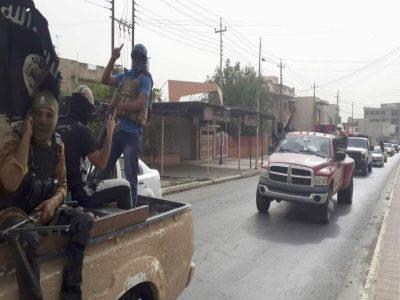
Frontline clinic window on hell of ISIS-held Mosul areas
The horrific wounds and gruesome accounts of the victims filling a frontline clinic in west Mosul in Iraq offer a window on the hell inside the last jihadist strongholds.
Dozens of wounded are rushed in every day to receive emergency assistance from the staff at the small facility of Al-Shabkhun in the heart of west Mosul, which has been engulfed in fighting since mid-February. Mahmud Mousa, 34, is one them.
He suffered face injuries as he fled his Tenek neighbourhood, which elite federal forces retook full control of on Tuesday after a week of fierce battles with the Islamic State group.
“We fled and that is when I was wounded,” he said, as helicopters hovered overhead and the thud of explosions sounded nearby.
“Thank God that no one else in my family was hurt. They left before me and are waiting for me to be transferred to a camp” for displaced civilians south of Mosul, said Mousa.
In mid-October last year, Iraqi forces launched a massive operation to retake Mosul, a large northern city seized by the jihadists in June 2014 that is the last major Iraqi stronghold of their now crumbling “caliphate”.
They retook the eastern half of the city, which is divided by the Tigris river, in January but the fighting in west Mosul has been even more intense and has exposed civilians more than ever.
An estimated 400,000 of them are believed to still be trapped in the Old City, which lies in west Mosul.
They are unwilling or unable to leave because any escape would be too dangerous or because the jihadists are using them as human shields.
Those who managed to flee and reach the Al-Shabkhun clinic in the liberated Mosul al-Jadida neighbourhood spoke of the harsh conditions and the fear they were subjected to every day.
“The people have nothing left to eat. Even water has become scarce,” said Mousa. “They (IS) kept us as human shields and they killed whoever tried to leave.”
Iraqi forces have set up checkpoints in areas of west Mosul they have liberated in order to carry out identity checks aimed at ensuring that jihadists do not infiltrate the ranks of fleeing civilians.
“The number of civilian casualties is increasing because Daesh (IS) fighters are targeting civilians and using them as human shields,” said an officer in charge of a military field hospital.
“Daesh is using chemical weapons as well… Less than an hour ago they used chlorine gas against military positions,” he said on Monday.
The officer pointed to two tents pitched nearby that he said would be used as decontamination units.
Aziz Myassar, a doctor at the Al-Shabkhun medical centre, said there was a pressing need to set up more clinics nearer to the frontline to meet a growing number of wounded among civilians.
“We opened this medical centre about a week ago, and it’s considered one of the closest medical centres to the frontlines,” he said.
Myassar said the clinic receives “tens of cases everyday” of civilians wounded by IS and by the shelling targeting the jihadists.
The clinic was set up with funds from the Iraqi Health Access Organisation which also dispatched a medical team of more than 40 people, including doctors and nurses.
One of the doctors is Ahmad Wael, a resident of east Mosul who drives two and a half hours to get to west Mosul and back every day.

“I have no other choice. I want to serve the people… and there are not many doctors in west Mosul,” he said.
Wael remembered life as a doctor in a clinic in east Mosul under IS rule.
“We were forced to work, they threatened us. Male doctors were not allowed to treat female patients unless it was an emergency, and even then a member of the Hisba (religious IS police) had to be present.”
Source: France24






You must be logged in to post a comment.